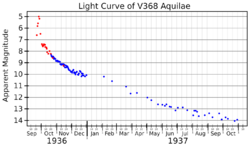Astronomy:V368 Aquilae
| Observation data Equinox J2000.0]] (ICRS) | |
|---|---|
| Constellation | Aquila |
| Right ascension | 19h 26m 34.460s[1] |
| Declination | 07° 36′ 13.81″[1] |
| Apparent magnitude (V) | 5.0 - 16.6[2] |
| Astrometry | |
| Proper motion (μ) | RA: −1.668[1] mas/yr Dec.: −0.730[1] mas/yr |
| Parallax (π) | 0.393[1] mas |
| Distance | 2722+612 −253[2] pc |
| Characteristics | |
| Variable type | Classical Nova, eclipsing binary |
| Other designations | |
Nova Aql 1936 2, AAVSO 1921+07, Gaia DR2 4295580518601261696[3] | |
| Database references | |
| SIMBAD | data |

V368 Aquilae, also known as Nova Aquilae 1936 no. 2 was the second nova which occurred in the constellation of Aquila during 1936 (the first was the fainter V356 Aquilae, which was discovered on 18 September 1936).[5] It was discovered on a photographic plate by Nils Tamm at Kvistaberg Observatory on 7 October 1936.[5] At the time of discovery it was at photographic magnitude 7, and was already fading.[6] Pre-discovery photographs showed that peak brightness occurred around 25 September 1936,[7] at which time it had reached apparent magnitude 5.0, making it visible to the naked eye.[2] The nova was described as being fiery red due to strong Hα emission, and for a time could be seen with binoculars simultaneously with V356 Aquilae, another nova which Nill Tamm had discovered a month earlier.[8]
V368 Aquilae is classified as a "moderately fast nova"; it dropped by three magnitudes in about 42 days.[9]
All novae are binary stars, with a "donor" star orbiting a white dwarf. The two stars are so close to each other that matter is transferred from the donor star to the white dwarf. Because the separation between the stars is comparable to the size of the donor star, these stars are often eclipsing binaries and V368 Aquilae does show eclipses. Marin and Shfter studied these eclipses, which have a depth of about 0.25 magnitudes and a period of 16.57 hours - an unusually long orbital period for a nova.[9]
References
- ↑ 1.0 1.1 1.2 1.3 1.4 Brown, A. G. A. (2021). "Gaia Early Data Release 3: Summary of the contents and survey properties". Astronomy & Astrophysics 649: A1. doi:10.1051/0004-6361/202039657. Bibcode: 2021A&A...649A...1G. Gaia EDR3 record for this source at VizieR.
- ↑ 2.0 2.1 2.2 Schaefer, Bradley E. (20 September 2018). "The distances to Novae as seen by Gaia". Monthly Notices of the Royal Astronomical Society 481 (3): 3033–3051. doi:10.1093/mnras/sty2388. Bibcode: 2018MNRAS.481.3033S.
- ↑ "V368 Aql". SIMBAD. Centre de données astronomiques de Strasbourg. http://simbad.u-strasbg.fr/simbad/sim-basic?Ident=V368+Aql.
- ↑ Parenago, P.P. (January 1949). "Final light curves of 6 Novas and 3 Supernovae". Peremennye Zvezdy 7: 109. Bibcode: 1949PZ......7..109P. https://ui.adsabs.harvard.edu/abs/1949PZ......7..109P. Retrieved 21 January 2021.
- ↑ 5.0 5.1 Duerbeck, Hilmar W. (March 1987). "A Reference Catalogue and Atlas of Galactic Novae". Space Science Reviews 45 (1–2): 1–14. doi:10.1007/BF00187826. Bibcode: 1987SSRv...45....1D.
- ↑ Klemola, A.R. (December 1968). "Field of Nova V368 Aquilae 1936". Publications of the Astronomical Society of the Pacific 80 (477): 706. doi:10.1086/128713. Bibcode: 1968PASP...80..706K.
- ↑ Wyse, A. B. (December 1936). "Novae of 1936". Publications of the Astronomical Society of the Pacific 48 (286): 302. doi:10.1086/124731. Bibcode: 1936PASP...48..302W.
- ↑ "Another New Star in Aquila". Nature 138 (3496): 756. 31 October 1936. doi:10.1038/138756b0. Bibcode: 1936Natur.138R.756..
- ↑ 9.0 9.1 Marin, E.; Shafter, A.W. (October 2009). "The Orbital Period of V368 Aquilae (Nova Aquilae 1936 No. 2)". Publications of the Astronomical Society of the Pacific 121 (884): 1090. doi:10.1086/644647. Bibcode: 2009PASP..121.1090M.
 |


